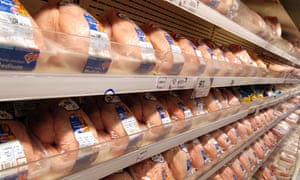Supermarkets urged to publish chicken contamination
test results
Consumer
group Which? asks stores to help stamp out campylobacter food poisoning by
making testing process more transparent
 Tesco is one of 10 supermarkets that has been asked to
share its campylobacter test results with shoppers. Photograph: Alamy
Tesco is one of 10 supermarkets that has been asked to
share its campylobacter test results with shoppers. Photograph: Alamy
All 10 leading UK supermarkets are being urged
by a consumer group to help stamp out a potentially lethal food-poisoning bug
present in the chickens they sell by regularly publishing the results of their
own internal tests.
On the eve of national food safety week,
Which? has written to the largest chains calling on them to shoulder “greater
responsibility” for testing of campylobacterlevels in chicken.
Which? says shoppers must be able to compare retailers’ progress through a more
transparent and consistent testing regime – and reduce their own risk – as they
seek reassurance that the chicken they buy is safe to eat.
Campylobacter continues to be the main cause
of food poisoning in the UK, according to official figures from the
Government’s food watchdog, the Food Standards Agency. But the FSA has recently
stopped measuring levels of the bacterium found in chicken while it works out a
new system of checking for the bug, which is said to be responsible for more than 280,000 cases of food poisoning,
and 100 deaths in the UK every year. That exercise alone cost £750,000 annually
and the FSA has also paused, for the moment, its work detailing the levels of
contamination at shops run by the big supermarket chains.
Retailers also do their own testing – and
share the results with the FSA – but, with the exception of Marks & Spencer
and Morrisons, do not routinely make the results public.
Which? said that while supermarkets have
demonstrated it is possible to put measures in place across the production
chain to reduce campylobacter in chickens, levels remain unacceptably high.
Around half of chickens are still contaminated and people continue to fall ill
as a result.
In the letter to supermarkets – which include
Tesco, Sainsbury’s, Asda, Aldi and Lidl – Which? director of policy and
campaigns Alex Neill said: “We have now reached a vital crossroads in the fight
against this potentially deadly bug. We believe it is time for much greater
transparency from retailers about testing and the extent to which the controls
put in place are proving effective.”
The industry is working towards a target, agreed
with the FSA, to reduce the number of the most contaminated birds to less than
10% by the end of 2016.
But Neill told the Observer:
“Despite the work by the regulator and the industry to reduce campylobacter in
chickens, levels remain too high and it still poses a significant risk to the
public.
“The FSA’s target and its regular testing has
put the dangerously high levels of contamination in the spotlight and has led
to reductions. It’s now time for retailers to shoulder greater responsibility
for the ongoing testing and they should be publishing their own data in a
comparable, consistent way.”
No comments:
Post a Comment